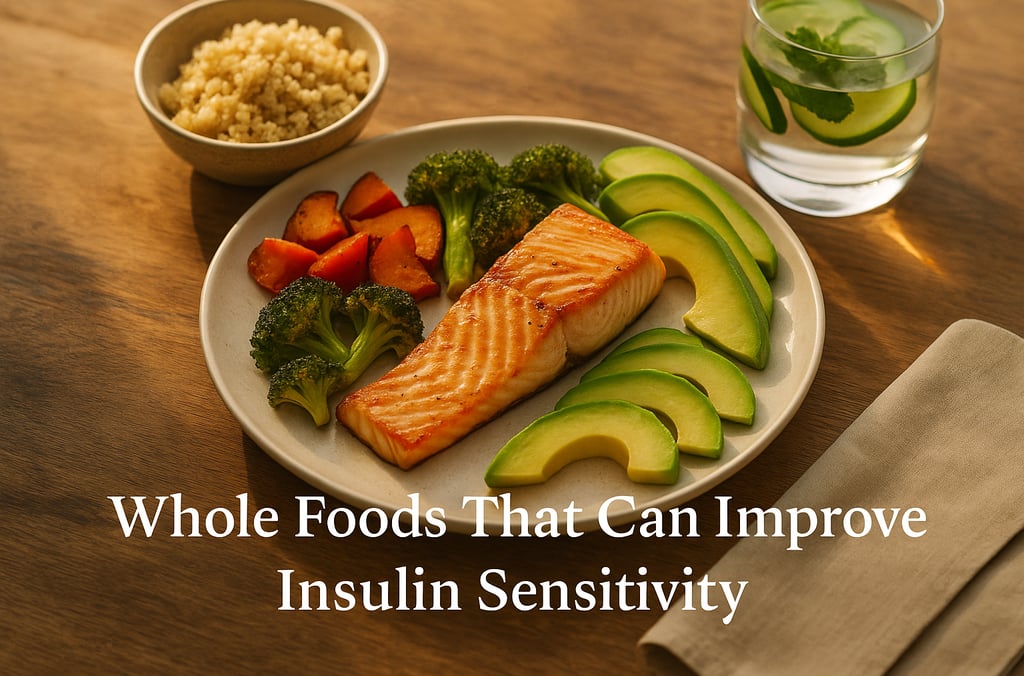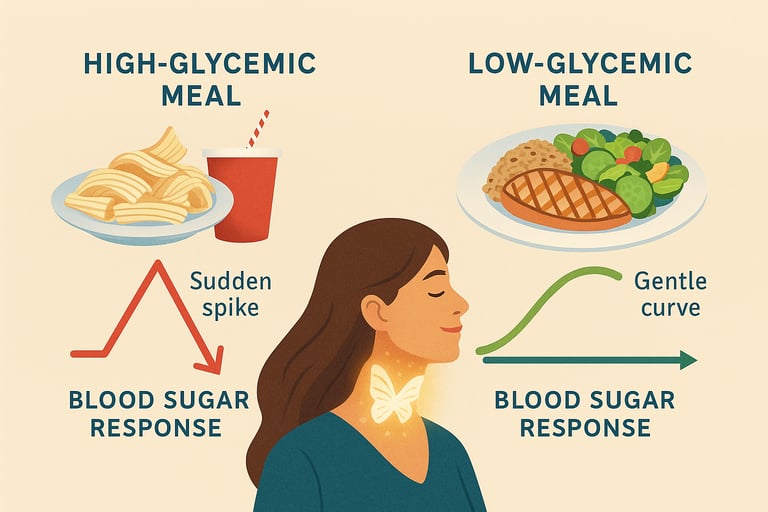Unlock Your Metabolism The Ultimate Guide to Improving Insulin Sensitivity Naturally with Diet
Unlock your metabolism & reclaim steady energy! This guide reveals how to improve insulin sensitivity naturally with diet. Get actionable tips for lasting health.
10/10/20256 min read


A Quiet Conversation That Your Body is Having
It happens every time you take a bite: a quiet, essential conversation between your cells and your food, facilitated by a hormone called insulin. If it all goes smoothly, your body is powered, your brain is functioning at peak level, and your health is fine. This is a state of being "insulin sensitive." But for many Americans, that conversation has hit on hard times, leading to what is called insulin resistance a harbinger of all sorts of metabolic woes.
The good news? You have a profound ability to change the tone of this conversation. You can lead your body back to sensitivity not with a magic pill, but with the very thing that starts the conversation in the first place: your food.
Insulin sensitivity is the degree to which your cells can respond to insulin in order to pull glucose out of your blood and use it for energy. High sensitivity is healthy; low sensitivity (resistance) is not.Your diet is your main tool. Eating whole, fiber rich, protein rich, and healthy fat rich foods while being clever with carbohydrates can make a huge difference in insulin sensitivity.
Certain plant chemicals (polyphenols) and gut friendly probiotics serve as great allies, complementing your body's natural glucose control mechanisms.Lifestyle elements like sleep, exercise, and stress management are non negotiable fundamentals that support any eating strategy.
In This Article
Understanding Insulin Sensitivity and Its Nemesis
The Dietary Blueprint for Enhanced Insulin Sensitivity
Nature's Metabolic Boosters Powerful Plant Compounds
The Gut-Insulin Axis How Probiotics Play a Role
Beyond the Plate Lifestyle Pillars for Insulin Health
Your Action Plan A Sample Day of Eating
Parting Words A Journey, Not a Destination
Understanding Insulin Sensitivity and Its Nemesis
Think of insulin as a key. When you eat carbs, your blood glucose level rises. Your pancreas releases insulin into your bloodstream, and it knocks on the doors of your cells. In an insulin sensitive person, the cells hear the knock, open the door, and allow glucose in to be used for fuel. Your blood glucose returns to normal, and all is well.
Insulin resistance is when your cells start tuning out the knock. The doors rust. Insulin keeps knocking more and more loudly (your pancreas releases more of it), but the doors remain shut. This allows too much glucose to continue floating around in your bloodstream, something that over time can lead to prediabetes, type 2 diabetes, PCOS, and other severe diseases. It's a state of metabolic traffic jam, and it's largely the result of modern diets and way of life.
The Dietary Roadmap to Increased Insulin Sensitivity
Increasing insulin sensitivity is about setting up a metabolic landscape where your cells can't wait to hear from insulin again. It begins with a planned, whole foods strategy.
Make Fiber Rich Foods Priority
Fiber:Fiber is a metabolic superhero. Soluble fiber, in particular, becomes gel like in your digestive system. This hinders the sugar's absorption, preventing those out-of-control blood sugar surges from putting your pancreas into hyperdrive.
Actionable Foods: Oats, barley, apples, citrus fruits, nuts, seeds (particularly flax and chia), beans, lentils, and veggies such as Brussels sprouts and broccoli.
Embrace High Quality Protein: Protein has virtually no impact on blood glucose. Having a good source of protein at each meal supports satiety, and that can prevent overeating and grabbing at high sugar foods. It also contributes to muscle mass, and muscle tissue is a prime location for the uptake of glucose.
Actionable Foods: Pasture raised chicken, grass fed beef, eggs, fish (wild caught, such as salmon), tempeh, and legumes.
Don't Fear Healthy Fats
The good fats are essential. Monounsaturated and omega-3 polyunsaturated fats can enhance the body's responsiveness to insulin and reduce inflammation, the primary source of insulin resistance.
Actionable Foods: Avocados, olive oil, almonds, walnuts, and fatty fish. Just as important is keeping inflammatory fats in process seed oils (like soybean and corn oil) and restaurant fried foods to a minimum.
Choose Carbohydrates Wisely
This isn't a reason to eliminate carbs entirely, but you do need to make some smart choices. Eliminate the processed, refined carbohydrates that crash into your bloodstream like a tidal wave.
Replace This: White bread, sugary breakfast cereal, pastries, soda pop, and candy.
With This: Sweet potatoes, quinoa, brown rice, squash, and whole fruits. These are "slow carbs" that come packaged with fiber, vitamins, and minerals, which means a less dramatic glucose response.
Nature's Metabolic Boosters Powerful Plant Compounds
Certain plants contain bioactive compounds called polyphenols that convey potent metabolic benefits. They are like tuning forks for your cellular machinery.
Berberine: Isolated in herbs like goldenseal, berberine has been the subject of a lot of research and has emerged as phenomenally useful at increasing insulin sensitivity, even becoming competitive with drugs in some cases.
Cinnamon: This spice is not just for flavoring. It has been found to delay stomach emptying and has constituents which may be able to mimic the action of insulin at a cellular level.
Green Tea: Green tea catechins, particularly EGCG, have been found to help the body metabolize carbohydrates more efficiently.
The Gut Insulin Axis Where Probiotics Come In
The trillions of bacteria in your gut are an integral part of your metabolic well-being. A healthy gut microbiome helps prevent inflammation and insulin resistance. Taking care of a healthy gut with probiotics beneficial bacteria can achieve this. Some research has shown that some probiotics can stimulate glucose metabolism and insulin sensitivity.
Actionable Foods: Incorporate fermented foods like plain yogurt (with live active cultures), kefir, sauerkraut, kimchi, and miso into your eating plan. They naturally have a variety of helpful bacteria.
Beyond the Plate: Lifestyle Pillars for Insulin Health
Eating is essential,these three pillars make it happen.
Sustained Movement: Exercise is one of the fastest ways to increase insulin sensitivity. When you exercise and contract your muscles, they can take up glucose from the blood via minimal insulin. The combination of weightlifting (resistance training) and cardiovascular exercise (brisk walking, biking) is best.
Get Sufficient Rest: Lack of sleep is a metabolic disaster. A single poor night's sleep can cause insulin resistance in people with normal metabolism. Attempt to get 7-9 hours of continuous, quality sleep every night.
Control Stress: Stress fills your body with cortisol, the hormone that tells your body to release stored glucose, keep blood sugar high, and push insulin resistance. Find what works for you: meditation, deep breathing, nature time, or a creative pursuit.
Your Action Plan A Sample Day of Eating
Here's how these ideas can look on a plate
Breakfast: Scrambled pasture raised eggs with mushrooms and spinach, made with olive oil, and half an avocado as a side.
Lunch: Grilled salmon over a large mixed green salad, chickpeas, cucumber, bell peppers, and lemon-tahini dressing.
Snack: One small apple and a one serving portion of almonds.
Dinner: Chicken thigh baked, accompanied by roasted sweet potatoes (skin on for fiber) and steamed broccoli.
A Targeted Solution We Trust
How great the diet and lifestyle advice we've shared are the key to recovering metabolic health, sometimes a targeted supplement can be the solution. We've detailed how powerful natural compounds like Berberine and Cinnamon act to normalize your body's blood sugar levels. For an easy, efficient way to introduce these helpers into your routine, we recommend Sugar Mute.
Sugar Mute is crafted specifically to address the root causes of metabolic stalling. It provides a synergistic blend of the extremely evidence backed ingredients we've discussed like Berberine and Cinnamon which work together in harmony to make your cells listen to insulin again. It's not a replacement for healthy habits, but an excellent catalyst of your efforts, adding reinforcement to your level blood sugar and naturally sensitized body.
If you feel as though you've hit a plateau or want to give your body the best support on this journey, Sugar Mute is a game changer. It bridges the gap between your dieting efforts and maximum cellular response.
Read the next step towards getting your metabolic health back and discover how Sugar Mute can help you here.
Parting Words A Journey, Not a Destination
Increasing your sensitivity to insulin is the most powerful thing you can do for your overall health long term. It's not a drastic, short term diet. It's about shifting your relationship to food and lifestyle into one that honors and supports your body's intricate metabolic machinery. With conscious, consistent actions, you can calibrate that quiet conversation in your body, leading to more energy, increased sense of well being, and a more abundant life.
References
The place of diet and exercise in the management of insulin resistance (2014-10-27)
The influence of Probiotics on glucose and lipid metabolism in type 2 diabetes mellitus (2019-03-01)
Polyphenols and their contribution to the management of human health (2018-12-01)


Health and Wellness
Your trusted source for health and fitness.
Connect
contact: beahealth.it@gmail.com
© 2025. All rights reserved.
